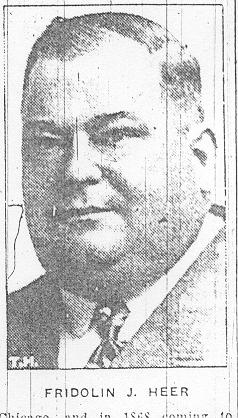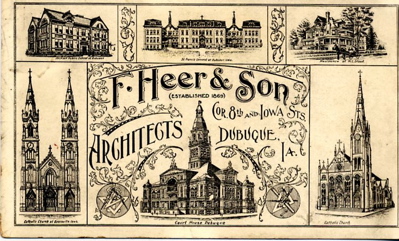Fridolin J. Heer, 76, Famed Architect, Dies
(Designer of Churches, Public Buildings Over Midwest)
Fridolin J. Heer, 76, widely known throughout the Midwest as an architect of churches, religious institutions, residences, and public buildings, died at his home, 2535 Traut Terrace, Friday night at 10:15 o'clock. Death resulted from a cerebral hemorrhage suffered last Saturday morning, Mr. Heer's seventy-sixth birthday anniversary.
The body is at the Hoffmann Mortuary, 1640 Main Street, from where the funeral will be held Monday morning to the Sacred Heart Church, where a mass of requiem will be offered at 9 o'clock. Burial will be in Mount Calvary Cemetery.
Mr. Heer was dean of Dubuque architects, having begun the practice of that profession in Dubuque 54 years ago with his father, Fridolin Heer Sr. and having continued since his father's death about 30 years ago.
(Born in Switzerland)
He was born Feb. 24, 1864, in Chur, Canton Graubuden, Switzerland, where his father was a successful architect and builder. A year after his birth his father emigrated to the United States, first settling at Belleville, Ill., then two years in Chicago, and in 1868 coming to Dubuque. The younger Heer was educated in the public and parochial schools, Loras College, and Bayless Business College. He then entered the employ of Bankmar, Adler, and Sullivan, well known Chicago architects. In 1881 he entered Campion College, Prairie du Chien, Wis., from where he was graduated in 1883.
Following his graduation from Campion College he went to Europe and entered the Koenigliche Baugewerkschule in Stuttgardt, Germany, where he was awarded his doctor's degree in architecture in 1886. He then returned to Dubuque and became associated with his father under the firm name of Frid, Heer, and Son. Other architects said of him that through his associations with his father, it was natural that he would become successful in every phrase of his work. They said of his original designs that they show natural skill and talent of artistic taste, and that the planning and arrangements of his buildings are splendid proofs of his abilities.
(Built Dubuque Courthouse)
Among the present buildings which he planned and erected in Dubuque, either in association with his father or individually, are the Dubuque County Courthouse, the church, parochial school, and auditorium of the Sacred Heart parish, St. Joseph's Academy, Mary of the Angel's Home, recent additions to St. Mary's Orphan Home, additions to St. Francis Mother House, St. Columbkille's Parochial School, Sunny Crest Sanitarium (now being used throughout the country as a model sanatorium design), Dubuque Brewing and Malting Company buildings, Dubuque Brunswick - Balke - Collender Company plant, Fischer Artificial Ice and Cold Storage Plant, Lorenz Laundry Plant, Security Building, and the Hoffmann Mortuary. Dubuque residences he planned include the Stout home, now occupied by Egelhof's Funeral Home, and the N.J. Schrup, W.S. Molo, and John Frantzen residences. He was also architect for the Fulton and Irving schools.
(Built Prairie due Chien Buildings)
Among buildings outside Dubuque which he planned and erected were St. Mary's Academy and College buildings, Marquette staute on the academy grounds, Campion College heating plant, and Charles Grelle home in Prairie du Chien, Wis.; and Catholic churches at Fort Madison, Ia., Pomeroy, Ohio, Oregon, Ill., Dyersville, Ia., and Wabasha, Minn. He also planned and erected many other Catholic schools, churches, orphan homes, and other structures in all parts of the midwest.
Mr. Heer was a lifelong Catholic, a member of the Sacred Heart parish, and affiliated with the St. Aloysius Society. He was president of the Dubuque Gruetli Verein, a member of the Dubuque Schuetzen Gesellschaft and the Dubuque lodge of Elks, a fellow of the American Institute of Architecture in which he was recently chosen as fellow emeritus, and on several occasions has served on national committees of this organization at Washington, D.C. He was co-founder of the Iowa State Chapter of the institute. His only entrance into the political field was when he was elected to the original board of trustees of the City Water Works.
(The Survivors)
He married Miss Marguerite Drasda, a daughter of Mr. and Mrs. Frank Drasda, Clinton, Ia., in June, 1910. Surviving with his wife are his sons, Fridolin A. Heer, Springfield, Ill., and Eugene F. Heer, Port Huron, Mich.; his daughter, Miss Marguerite Heer, Dubuque; his sisters, Miss Pauline Heer and Miss Elise Heer, both living at the Heer residence on Traut Terrace; and his grandson, William Heer, Springfield, Ill.
Dubuque Daily Herald, June 5, 1901
Fridolin. Heer, Jr., the well-known architect, will be married tomorrow at Lyons, Ia., to Miss Marguerite Drasta, a prominent society lady of that place. After the wedding Mr. and Mrs. Heer will return to Dubuque to make this their future home.
Fridolin J. Heer, 76, Famed Architect, Dies
(Designer of Churches, Public Buildings Over Midwest)
Fridolin J. Heer, 76, widely known throughout the Midwest as an architect of churches, religious institutions, residences, and public buildings, died at his home, 2535 Traut Terrace, Friday night at 10:15 o'clock. Death resulted from a cerebral hemorrhage suffered last Saturday morning, Mr. Heer's seventy-sixth birthday anniversary.
The body is at the Hoffmann Mortuary, 1640 Main Street, from where the funeral will be held Monday morning to the Sacred Heart Church, where a mass of requiem will be offered at 9 o'clock. Burial will be in Mount Calvary Cemetery.
Mr. Heer was dean of Dubuque architects, having begun the practice of that profession in Dubuque 54 years ago with his father, Fridolin Heer Sr. and having continued since his father's death about 30 years ago.
(Born in Switzerland)
He was born Feb. 24, 1864, in Chur, Canton Graubuden, Switzerland, where his father was a successful architect and builder. A year after his birth his father emigrated to the United States, first settling at Belleville, Ill., then two years in Chicago, and in 1868 coming to Dubuque. The younger Heer was educated in the public and parochial schools, Loras College, and Bayless Business College. He then entered the employ of Bankmar, Adler, and Sullivan, well known Chicago architects. In 1881 he entered Campion College, Prairie du Chien, Wis., from where he was graduated in 1883.
Following his graduation from Campion College he went to Europe and entered the Koenigliche Baugewerkschule in Stuttgardt, Germany, where he was awarded his doctor's degree in architecture in 1886. He then returned to Dubuque and became associated with his father under the firm name of Frid, Heer, and Son. Other architects said of him that through his associations with his father, it was natural that he would become successful in every phrase of his work. They said of his original designs that they show natural skill and talent of artistic taste, and that the planning and arrangements of his buildings are splendid proofs of his abilities.
(Built Dubuque Courthouse)
Among the present buildings which he planned and erected in Dubuque, either in association with his father or individually, are the Dubuque County Courthouse, the church, parochial school, and auditorium of the Sacred Heart parish, St. Joseph's Academy, Mary of the Angel's Home, recent additions to St. Mary's Orphan Home, additions to St. Francis Mother House, St. Columbkille's Parochial School, Sunny Crest Sanitarium (now being used throughout the country as a model sanatorium design), Dubuque Brewing and Malting Company buildings, Dubuque Brunswick - Balke - Collender Company plant, Fischer Artificial Ice and Cold Storage Plant, Lorenz Laundry Plant, Security Building, and the Hoffmann Mortuary. Dubuque residences he planned include the Stout home, now occupied by Egelhof's Funeral Home, and the N.J. Schrup, W.S. Molo, and John Frantzen residences. He was also architect for the Fulton and Irving schools.
(Built Prairie due Chien Buildings)
Among buildings outside Dubuque which he planned and erected were St. Mary's Academy and College buildings, Marquette staute on the academy grounds, Campion College heating plant, and Charles Grelle home in Prairie du Chien, Wis.; and Catholic churches at Fort Madison, Ia., Pomeroy, Ohio, Oregon, Ill., Dyersville, Ia., and Wabasha, Minn. He also planned and erected many other Catholic schools, churches, orphan homes, and other structures in all parts of the midwest.
Mr. Heer was a lifelong Catholic, a member of the Sacred Heart parish, and affiliated with the St. Aloysius Society. He was president of the Dubuque Gruetli Verein, a member of the Dubuque Schuetzen Gesellschaft and the Dubuque lodge of Elks, a fellow of the American Institute of Architecture in which he was recently chosen as fellow emeritus, and on several occasions has served on national committees of this organization at Washington, D.C. He was co-founder of the Iowa State Chapter of the institute. His only entrance into the political field was when he was elected to the original board of trustees of the City Water Works.
(The Survivors)
He married Miss Marguerite Drasda, a daughter of Mr. and Mrs. Frank Drasda, Clinton, Ia., in June, 1910. Surviving with his wife are his sons, Fridolin A. Heer, Springfield, Ill., and Eugene F. Heer, Port Huron, Mich.; his daughter, Miss Marguerite Heer, Dubuque; his sisters, Miss Pauline Heer and Miss Elise Heer, both living at the Heer residence on Traut Terrace; and his grandson, William Heer, Springfield, Ill.
Dubuque Daily Herald, June 5, 1901
Fridolin. Heer, Jr., the well-known architect, will be married tomorrow at Lyons, Ia., to Miss Marguerite Drasta, a prominent society lady of that place. After the wedding Mr. and Mrs. Heer will return to Dubuque to make this their future home.
Family Members
Sponsored by Ancestry
Advertisement
Records on Ancestry
Advertisement











